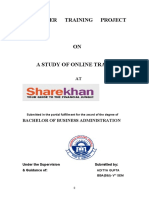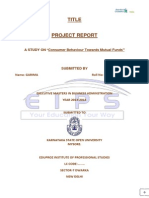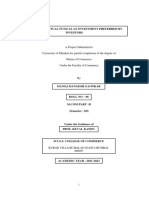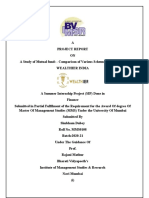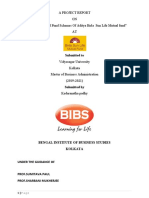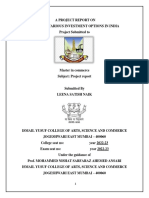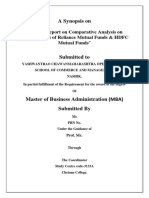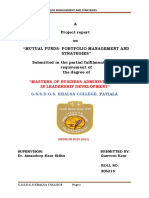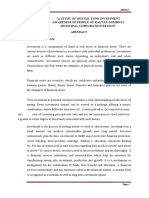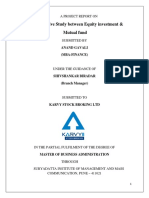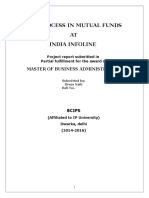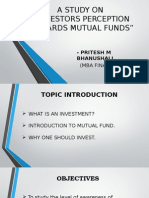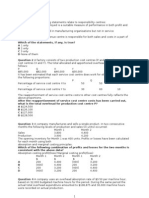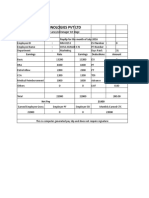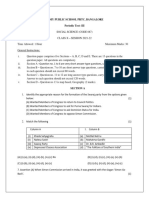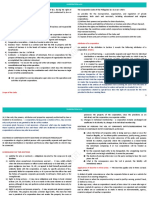A Project Report ON "Investors Perception Towards Mutual Funds"
Uploaded by
priteshA Project Report ON "Investors Perception Towards Mutual Funds"
Uploaded by
priteshInvestors perception towards mutual
funds
A
PROJECT REPORT
ON
INVESTORS PERCEPTION TOWARDS MUTUAL FUNDS
A Report Submitted To University Of Pune
In Partial Fulfilment Of The Degree Of
MASTER OF BUSINESS ADMINISTRATION
2014-2016
SUBMITTED
BY
PRITESH M BHANUSHALI
MBA FINANCE
UNDER THE GUIDANCE OF
PROF. SUNIL MAHAJAN SIR
Investors perception towards mutual
funds
A
PROJECT REPORT
ON
INVESTORS PERCEPTION TOWARDS MUTUAL FUNDS
By
PRITESH M BHANUSHALI
Under the Guidance of
Mrs. SANGEETHASRUTHI
WAY TO WEALTH CONSULTING
Investors perception towards mutual
funds
ACKNOWLEDGEMENT
I would like to express my gratitude to my project guide Prof. Sunil Mahajan who gave
me this golden opportunity to do the wonderful project on the topic- Investors
perception towards Mutual Fund, which also helped me in doing a lot of research and I
came to know about so many new things.
I have also been benefited greatly from the advice and counsel of the co-founder of way
to wealth consulting Mrs.Sangeethasruthi where i did my internship and i am happy to
express my grateful thanks to her.
Secondly i would also like to thank my parents and friends who helped me a lot in
finalizing this project within the limited time frame.
Investors perception towards mutual
funds
DECLARATION
I Mr.Pritesh M Bhanushali, hereby declare that the Project Report entitled
Investors Perception Towards Mutual Funds , written and submitted by me to the
University of Pune, Partial fulfilment of the requirement for the award of degree of
Master of Business Administration under the guidance of Prof. Sunil Mahajan. It is my
original work and the conclusions drawn there in are based on the Collected Material by
Myself.
The information submitted is true and original to the best of my knowledge.
Pritesh M Bhanushali
Place: Pune
Date:
/08/2015
PREFACE
4
Investors perception towards mutual
funds
The successful completion of this project was a unique experience for me because by
visiting many place and interacting various person ,I achieved a better knowledge about
sales . The experience which I gained by doing this project was essential at this turning
point of my carrier . this project is being submitted which content detailed analysis of the
research under taken by me.The research provides an opportunity to the student to
devote his/her skills knowledge and competencies required during the technical session.
The research is on the topic INVESTORS PERCEPTION TOWARDS MUTUAL
FUND
EXECUTIVE SUMMARY
Investment can be defined as an item of value purchased for income or capital appreciation.
Investments are made to achieve a specific objective and savings are made to meet an
unforeseen event.
There are various avenues of investments in accordance with individual preferences. Investments are
made in different asset classes depending upon on an individuals risk and return characteristics.
Investment choices are physical assets and financial assets.
Gold and Real estates
a physical form to them.
are
examples
of
physical
assets,
which
have
Another avenue of investment is mutual funds. It is created when investors put their
money together. It is therefore a pool of the investors funds. The most important
characteristics of a mutual fund is that the contributors and the beneficiaries of the fund
are the same class of people, namely the investors.
The term mutual means that investors contribute to the pool, and also benefit from the
pool. There are no other claimants to the funds. The pool of funds held mutually by
investors is the mutual fund.
The money in turn is invested in various securities depending on the objectives of the
mutual fund scheme, and the profits (or loss) are shared among investors in proportion to
their investments.
Mutual fund schemes are usually open-ended (perpetually open for investments and
redemptions) or closed end (with a fixed term). A mutual fund scheme issues units that
are normally priced at Rs.10 during the initial offer. Thus, the number of units you own as
against the total number of units issued by the mutual fund scheme determines your share
5
Investors perception towards mutual
funds
in the profits or loss of a scheme. In the case of open-end schemes, units can be
purchased from or sold back to the fund at a Net Asset Value (NAV) based price on all
business days.
The NAV is the actual value of a unit of the fund on a given day .Thus, when you invest
in a mutual fund scheme, you normally get an account statement mentioning the number
of units that have been allotted to you and the NAV based price at which the units have
been allotted. The account statement is similar to your bank statement.
Mutual funds invest basically in three types of asset classes:
Stocks:
Stocks represent ownership or equity in a company, popularly known as shares.
Bonds:
These represent debt from companies, financial institutions or Government agencies.
Money market instruments:
These include short-term debt instruments such as treasury bills, certificate of deposits
and inter-bank call money.
A mutual funds business is to invest the funds thus collected, according to the wishes of
the investors who created the pool. In many markets these wishes are articulated as
investment mandates .Analysis of The perception towards these mutual funds is done
herein this project. Even what factors the investors look before investing can also be
observed.
Investors perception towards mutual
funds
INDEX CONTENTS
CHAPTE
R NO
1
2
3
4
5
6
7
8
9
10
11
12
13
14
15
16
17
18
19
7
CONTENTS
Company Profile
Review of Literature
Research Methodology
Contents of Mutual Funds
Introduction
History
Advantages and Disadvantages
Types
Mutual Funds Constituents
Investment Strategy SIP
Role of SEBI
Mutual Funds Emerging Challenges
Marketing Strategy adopted by Mutual Fund
Comparison of other avenues with Mutual Funds
Risks involved in Mutual Funds
How to choose a Fund?
Data Analysis and Interpretation
Findings
Recommendations
Conclusion
Learnings
Bibliography
Annexture
PAGE
NO
9 11
12 13
14 15
16 24
25 26
27 29
30 31
32 33
34 35
36 38
39 40
41 42
43 54
55
56
57
58
59
61
Investors perception towards mutual
funds
COMPANY PROFILE
Introduction
WAYtoWEALTH is a firm which deals as a Financial Consultant, Financial Planner,
Financial Coach and Financial Educator.
They are financial planning specialist not just because of their world class expertise Or
companys top notch consultants who deliver unbiased game-changing advice every
single time. Or their innate capacity of doing the right things for the right reasons.
All that makes the waytowealth consulting the best in the business, but what truly makes
waytowealth specialists is their range of offering which covers the entire Financial
Planning ecosystem.
Company offer Premium Financial Planning to the person who values in-person expertise
the most, co-habits our locations with us & wishes to work with an expert Financial
Planner who doubles up as a Financial Coach, extensively, all year round.
For the connoisseur of expertise who doesnt co-habit their location companys Expert
Online Advice is available seamlessly. The same specialized services without the
geographical barriers.
The person wanting to Start Investing Now, with expectation of only returns & not hassle,
they have an online interface to do just that for him. And a Wealth Management arm to
manage all his investments.
Investors perception towards mutual
funds
Waytowealth do all this, but also strive to leave a legacy behind, hence the company take
great pride in pioneering a Training Academy that imparts World-Class Financial
Education to foster the next generation of exemplary Consultants as well as train
corporate employees in finances to complete their leadership skills.
FOUNDERS
Founder and Chief Strategist - Rahul Kalra
Co-founder,
Chief Consultant and Financial Planner.- Sangeethasruthi S
ESTABLISHMENT
Way to wealth is a Financial Consultancy that has been launched in 2014.
ITS MISSION
We Plan to change the world.
One Financial Plan at a time.
THEIR PRODUCTS
Premium Financial Plan They offer Premium Financial Planning to the person who values in-person expertise the
most & wishes to work with an expert Financial Planner who doubles up as a Financial
Coach, extensively, all year round.
Expert Online Advice
A Specialist of a given field whose opinion is valued gives Expert Online
Advice for the individuals who wish to make a Financial Plan.
Start Investing Now The person wanting to Start Investing Now, with expectation of only returns & not
hassle, we have an online interface to do just that for him. And a Wealth Management
arm to manage all his investments.
9
Investors perception towards mutual
funds
Training Academic They do all this, but also strive to leave a legacy behind, hence they take great pride in
pioneering a Training Academy that imparts World-Class Financial Education to foster
the next generation of exemplary Consultants as well as train corporate employees in
finances to complete their leadership skills.
WEBSITE
http://www.waytowealthconsulting.com
INDUSTRY
Financial Services
TYPE
Privately Held
COMPANY SIZE
1-10 employees
ROLES PLAYED BY THEM: Financial Consultant
As Consultants, they give Expert Personal Financial advice.
Financial Planner
As planners they are strategists. They build your financial roadmap, they plan your
finances and investments which is known as a Financial Plan.
Financial Coach
As a Financial Coach they mentor and they educate.
10
Investors perception towards mutual
funds
Financial Educator
As educators they are teachers and mentors who believe in creating the next generation of
top notch consultants in India.
As trainers they train non finance managers in the essential domain skill of
understanding finances.
THREE CS ANALYSIS
Company :Company is offering premium Financial Planning, Start Investing Now that is online way
of investing, they are providing free online expert advice about financial planning which
can be availed any time at any place.
Competitors :Other financial consultants are their competitors like bharati consultancy keshavnagarmundhawa, sanraya investment advisor pvt ltd. Etc.waytowealth is different from their
competitors because of the service they provide the online service and the education in
financial planning.
Customers :The company is targeting the one who is earning and who has small goal in life to
achieve and who need a financial planning to meet the future expenses.
11
Investors perception towards mutual
funds
REVIEW OF LITERATURE
McDonald and John (1974) examined 123 mutual funds and identified
the existence of positive relationship between objectives and risk. The
study identified the existence of positive relationship between return and risk. The
relationship between objective and risk-adjusted performance indicated that, more
aggressive funds experienced better results.
Obaidulla and Sridhar (1991) evaluated the performance of two major
growth oriental mutual fund schemes - Master share and Canshare. They both concluded
that both the funds provided abnormal returns. Master share out performed based on
market risk.
Gupta (1994) made a household investor survey with the objective to
provide data on the investor preferences on Mutual Funds and other
financial assets. The findings of the study were more appropriate, at that time, to the
policy makers and mutual funds to design the financial products for the future.
Conrad S Ciccotello and C Terry Grants (1996) study identified a
negative correlation between asset size of the fund and the expense ratio. The results of
the study brought out that, larger funds had lower expense acquire information for trading
decision and were consistent with the theory of information pricing.
12
Investors perception towards mutual
funds
Anand and Murugaiah (2004) had studied various strategic issues related to the
marketing offinancial services. They found that recently this type of industry requires
new strategies tosurvive and for operation. For surviving they have to adopt new
marketing strategies andtactics that enable them to capture maximum opportunities with
the lowest risks in order to enable them to survive and meet the competition from various
market players globally
Ramamurthy and Reddy (2005) conducted a study to analyze recent trends in the
mutual fund industry and draw a conclusion that the main benefits for small investors
due to efficient management, diversification of investment, easy administration, nice
return potential, liquidity, transparency, flexibility, affordability, wide range of choices
and a proper regulation governed by SEBI. The study also analyzed about recent trends in
mutual fund industry like various exit and entry policies of mutual fund companies,
various schemes related to real estate, commodity, bullion and precious metals, entering
of banking sector in mutual fund, buying and selling of mutual funds through online
Desigan et al (2006) conducted a study on women investors perception towards
investment and found that women investors basically are indecisive in investing in
mutual funds due to various reasons like lack of knowledge about the investment
protection and their various investment procedures, market fluctuations, various risks
associated with investment, assessment of investment and redressal of grievances
regarding their various investment related problems. Savings is a habit specially
embodied into women. Even in the past, when women mainly depended on their spouses
income, they used to save to meet emergencies as well as for future activities. In those
days, women did not have any awareness about various investment outlets. But as time
passed, the scenario has totally changed.
Deepak Agarwal (2011), Mutual fund contributes to globalization of financial markets
and is one among the main sources for capital formation in emerging economies. He
analyzed the pricing mechanism of Indian Mutual Fund Industry, data at both the fundmanager and fund-investor levels. There has been incredible growth in the mutual fund
industry in India, attracting large investments from domestic and foreign investors.
Kalpesh P Prajapati and Mahesh K Patel (2012),
evaluated the performance of Indian mutual funds using relative performance index, riskreturn analysis, Treynor's ratio, Sharp's ratio, Sharp's measure, Jensen's measure, and
13
Investors perception towards mutual
funds
Fama's measure. The data used is daily closing NAVs from 1st January 2007 to 31st
December, 2011 and concluded that most of the mutual funds have given positive return
during the period of study.
RESEARCH METHODOLOGY
Research Methodology can be defined as, giving a clear cut idea on what methods or
process the researcher is going to use in his research to achieve research objectives. In
order to plan for the whole research process at a right point of time and to advance the
research work in the right direction, carefully chosen research methodology is very
critical.
TOPIC
Study of Investors Perception Towards Mutual Fund.
OBJECTIVES OF THE STUDY
To study the level of awareness of mutual funds
To analyse the perception of investors towards mutual funds.
To study the factors considered by the investors and those which
ultimately influence him while investing.
To determine the type of mutual fund investor prefers the most.
RESEARCH INSTRUMENT:
14
Investors perception towards mutual
funds
A well- structured questionnaire are used which are multiple choices questions that are
used for collections of certain information.
QUESTIONNAIRE DESIGN:
The questionnaire designed is one consisting of multiple choices.
DATA COLLECTION:
Nature of data: The nature of data is both primary and secondary data.
Primary data:
Descriptive research design is been used for the study. Primary data was collected from
investors. Survey method and personal interview method was used to collect data from
consumer.
Secondary data:
The secondary data was collected from websites and blogs.
SAMPLE SIZE:
The sampling size of 95 investors selected for the survey.
15
Investors perception towards mutual
funds
FIELD AREA: Mumbai
LIMITATIONS OF THE STUDY
Some of the persons were not so responsive.
Possibility of error in Data Collection because many of investors may not have
given correct answer for my questionnaire.
There was no proper knowledge about Mutual Funds to many Investors.
CONTENTS OF MUTUAL FUNDS
1) INTRODUCTION
A mutual fund is a financial intermediary that pools the savings of investors for collective
investment in a diversified portfolio of securities. A fund is mutual as all of its returns,
minus its expenses, are shared by the funds investors.
The Securities and Exchange Board of India (Mutual Funds) Regulations, 1996 defines a
mutual fund as a a fund established in the form of a trust to raise money through the sale
of
units to the public or a section of the public under one or more schemes for investing in
securities, including money market instruments.
According to the above definition, a mutual fund in India can raise resources through sale
of units to the public. It can be set up in the form of a Trust under the Indian Trust Act.
The
definition has been further extended by allowing mutual funds to diversify their activities
in the following areas:
Portfolio management services
Management of offshore funds
Providing advice to offshore funds
Management of pension or provident funds
Management of venture capital funds
Management of money market funds
16
Investors perception towards mutual
funds
Management of real estate funds
A mutual fund serves as a link between the investor and the securities market by
mobilising savings from the investors and investing them in the securities market to
generate returns.
Thus, a mutual fund is a kin to portfolio management services (PMS). Although, both are
conceptually same, they are different from each other. Portfolio management services are
offered to high net worth individuals; taking into account their risk profile, their
investments are managed separately. In the case of mutual funds, savings of small
investors are pooled under a scheme and the returns are distributed in the same proportion
in which the investments are made by the investors/unit-holders.
Mutual fund is a collective savings scheme. Mutual funds play an important role in
mobilising the savings of small investors and channelising the same for productive
ventures in the Indian
economy.
2) HISTORY MUTUAL FUNDS
The history of mutual funds in India can be broadly divided into four distinct phases
FIRST PHASE 1964-87
Unit Trust of India (UTI) was established on 1963 by an Act of Parliament. It was set up
by the Reserve Bank of India and functioned under the Regulatory and administrative
control of the Reserve Bank of India. In 1978 UTI was de-linked from the RBI and the
Industrial Development Bank of India (IDBI) took over the regulatory and administrative
control in place of RBI. The first scheme launched by UTI was Unit Scheme 1964. At the
end of 1988 UTI had Rs.6,700 crores of assets under management.
SECOND PHASE 1987-1993 (ENTRY OF PUBLIC SECTOR FUNDS)
1987 marked the entry of non- UTI, public sector mutual funds set up by public sector
banks and Life Insurance Corporation of India (LIC) and General Insurance Corporation
of India (GIC). SBI Mutual Fund was the first non- UTI Mutual Fund established in June
1987 followed by Canbank Mutual Fund (Dec 87), Punjab National Bank Mutual Fund
(Aug 89), Indian Bank Mutual Fund (Nov 89), Bank of India (Jun 90), Bank of Baroda
Mutual Fund (Oct 92). LIC established its mutual fund in June 1989 while GIC had set
up its mutual fund in December 1990. At the end of 1993, the mutual fund industry had
assets under management of Rs.47,004 crores.
17
Investors perception towards mutual
funds
THIRD PHASE 1993-2003 (ENTRY OF PRIVATE SECTOR FUNDS)
With the entry of private sector funds in 1993, a new era started in the Indian mutual fund
industry, giving the Indian investors a wider choice of fund families. Also, 1993 was the
year in which the first Mutual Fund Regulations came into being, under which all mutual
funds, except UTI were to be registered and governed. The erstwhile Kothari Pioneer
(now merged with Franklin Templeton) was the first private sector mutual fund registered
in July 1993. The 1993
SEBI (Mutual Fund) Regulations were substituted by a more comprehensive and revised
Mutual Fund Regulations in 1996. The industry now functions under the SEBI (Mutual
Fund) Regulations 1996. The number of mutual fund houses went on increasing, with
many foreign mutual funds setting up funds in India and also the industry has witnessed
several mergers and acquisitions. As at the end of January 2003, there were 33 mutual
funds with total assets of Rs. 1,21,805 crores. The Unit Trust of India with Rs.44,541
crores of assets under management was way ahead of other mutual funds.
FOURTH PHASE SINCE FEBRUARY 2003
In February 2003, following the repeal of the Unit Trust of India Act 1963 UTI was
bifurcated into two separate entities. One is the Specified Undertaking of the Unit Trust
of India with assets under management of Rs.29,835 crores as at the end of January 2003,
representing broadly, the assets of US 64 scheme, assured return and certain other
schemes. The Specified Undertaking of Unit Trust of India, functioning under an
administrator and under the rules framed by Government of India and does not come
under the purview of the Mutual Fund Regulations.
The second is the UTI Mutual Fund, sponsored by SBI, PNB, BOB and LIC. It is
registered with SEBI and functions under the Mutual Fund Regulations. With the
bifurcation of the erstwhile UTI which had in March 2000 more than Rs.76,000 crores of
assets under management and with the setting up of a UTI Mutual Fund, conforming to
the SEBI Mutual Fund Regulations, and with recent mergers taking place among different
private sector funds, the mutual fund industry has entered its current phase of
consolidation and growth.
3) ADVANTAGES AND DISADVANTAGES
Advantages of Investing into a Mutual Fund: Flexibility - Mutual Fund investments offers a lot of flexibility with features such as
systematic investment plans, systematic withdrawal plans & dividend reinvestment.
18
Investors perception towards mutual
funds
Affordability - They are available in units so this makes it very affordable. Because of
the large corpus, even a small investor can benefit from its investment strategy.
Liquidity - In open-ended schemes, there is an option of withdrawing or redeeming
money.
Diversification - Risk is lowered with Mutual Funds as they invest across different
industries & stocks.
Professional Management - Expert Fund Managers of the Mutual Fund analyze all
options based on experience & research.
Potential of return -The fund managers who take care of Mutual Fund have access to
information and statistics from leading economists and analysts around the world.
Because of this, they are in a better position than individual investors to identify
opportunities for investments to flourish.
Economies of Scale: Because a mutual fund buys and sells large amounts of securities
at a time, its transaction costs are lower than as an individual would pay.
Simplicity Buying a mutual fund is easy. When an investor invest in the mutual fund
then they need to take form, fill it according to required instructions given and give the
demand draft or cheque of amount whatever they want to invest.
Reduced risk: - As mutual funds invests in large number of companies and are managed
professionally, the risk factor of the investor is reduced. A small investor, on the other
hand, may not be in position to minimize the such risk.
Tax advantage: - There are certain schemes of mutual fund which provide tax advantage
under income tax act. Thus tax liability of investor also reduced when he invest in mutual
fund schemes.
Low operating cost: - Mutual fund has large number of investible funds at their disposal
and thus can avail the large scale of economies. This reduces their operating cost by way
of brokerage, fees, commission etc. Thus, an investor can also gets the benefits of large
scale of economies and low operating cost.
DISADVANTAGES OF MUTUAL FUNDS
19
Investors perception towards mutual
funds
Risks and Costs:
Changing market conditions can create fluctuations in the value of a mutual fund
investment. Also there are fees and expenses associated with investing in mutual funds
that do not usually occur when purchasing individual securities directly.
No Guarantees:
As Mutual funds invest in debt as well equities , there are no sure returns . Returns
depends on the market conditions .
No Control:
Investor does not have control on investment , all the decisions are taken by the fund
manager. Investor can just join or leave the show.
Difficulty in Selecting a Suitable Fund Scheme :
Many investors find it difficult to select one option from the plethora of
funds/schemes/plans available. For this, they may have to take advice from financial
planners in order to invest in the right fund to achieve their objectives.
Selecting right financial securities is not easy :
It's difficult task for a mutual fund manager to select appropriate and suitable financial
securities for investment to generate higher returns.
4) TYPES OF MUTUAL FUND
Wide varieties of Mutual Fund Schemes exist to cater to the needs such as financial
position, risk tolerance and return expectations etc. Following are the types A) BY STRUCTURE
Open - Ended Schemes:
An open-ended fund or scheme is one that is available for subscription and repurchase
on a continuous basis. These schemes do not have a fixed maturity period. Investors can
conveniently buy and sell units at Net Asset Value (NAV) related prices, which are
declared on a daily basis. The key feature of open-end schemes is liquidity.
20
Investors perception towards mutual
funds
Close - Ended Schemes:
A close-ended fund or scheme has a stipulated maturity period e.g. 5-7 years. The fund is
open for subscription only during a specified period at the time of launch of the scheme.
Investors can invest in the scheme at the time of the initial public issue and thereafter
they can buy or sell the units of the scheme on the stock exchanges where the units are
listed. In order to provide an exit route to the investors, some close-ended funds give an
option of selling back the units to the mutual fund through periodic repurchase at NAV
related prices. SEBI Regulations stipulate that at least one of the two exit routes is
provided to the investor i.e. either repurchase facility or through listing on stock
exchanges. These mutual funds schemes disclose NAV generally on weekly basis.
Interval Scheme:
These combine the feature of open-ended and close ended schemes. They may be traded
on the stock exchange or may be open for sale or redemption during predetermined
intervals at NAV related prices.
B) BY INVESTMENT OBJECTIVE
Growth Schemes:
The aim of growth funds is to provide capital appreciation over the medium to longterm. Such schemes normally invest a major part of their corpus in equities. Such funds
have comparatively high risks. These schemes provide different options to the investors
like dividend option, capital appreciation, etc. and the investors may choose an option
depending on their preferences. The investors must indicate the option in the application
form. The mutual funds also allow the investors to change the options at a later date.
21
Investors perception towards mutual
funds
Growth schemes are good for investors having a long-term outlook seeking appreciation
over a period of time.
Income Schemes:
The aim of income funds is to provide regular and steady income to investors. Such
schemes generally invest in fixed income securities such as bonds, corporate debentures,
Government securities and money market instruments. Such funds are less risky
compared to equity schemes. These funds are not affected because of fluctuations in
equity markets. However, opportunities of capital appreciation are also limited in such
funds. The NAVs of such funds are affected because of change in interest rates in the
country. If the interest rates fall, NAVs of such funds are likely to increase in the short run
and vice versa. However, long term investors may not bother about these fluctuations.
Balanced Schemes:
The aim of balanced funds is to provide both growth and regular income as such schemes
invest both in equities and fixed income securities in the proportion indicated in their
offer documents. These are appropriate for investors looking for moderate growth. They
generally invest 40-60% in equity and debt instruments. These funds are also affected
because of fluctuations in share prices in the stock markets. However, NAVs of such
funds are likely to be less volatile compared to pure equity funds.
Money Market Schemes:
These funds are also income funds and their aim is to provide easy liquidity, preservation
of capital and moderate income. These schemes invest exclusively in safer short-term
instruments such as treasury bills, certificates of deposit, commercial paper and interbank call money, government securities, etc. Returns on these schemes fluctuate much
less compared to other funds. These funds are appropriate for corporate and individual
investors as a means to park their surplus funds for short periods.
Gilt Fund:
These primarily invest in government debts. Hence, the investor usually does not have to
worry about credit risk since government debt is generally credit risk free. Reliance Gilt
22
Investors perception towards mutual
funds
Securities Fund - Short Term Gilt Plan & Long Term Gilt Plan are best example of such
scheme.
C) OTHER SCHEMES
Tax Saving Schemes:
These schemes offer tax rebates to the investors under specific provisions of the Income
Tax Act, 1961 as the Government offers tax incentives for investment in specified
avenues. E.g. Equity Linked Savings Schemes (ELSS). Pension schemes launched by the
mutual funds also offer tax benefits. These schemes are growth oriented and invest predominantly in equities. Their growth opportunities and risks associated are like any
equity-oriented scheme.
Index Schemes:
Index Funds replicate the portfolio of a particular index such as the BSE Sensitive index,
S&P NSE 50 index (Nifty), etc. These schemes invest in the securities in the same weight
age comprising of an index. NAVs of such schemes would rise or fall in accordance with
the rise or fall in the index, though not exactly by the same percentage due to some
factors known as "tracking error" in technical terms. Necessary disclosures in this regard
are made in the offer document of the mutual fund scheme. There are also exchange
traded index funds launched by the mutual funds which are traded on the stock
exchanges.
Sector Specific Schemes:
These are the funds/schemes which invest in the securities of only those sectors or
industries as specified in the offer documents. E.g. Pharmaceuticals, Software, Fast
Moving Consumer Goods (FMCG), Petroleum stocks, etc. The returns in these funds are
dependent on the performance of the respective sectors/industries. While these funds may
give higher returns, they are more risky compared to diversified funds. Investors need to
keep a watch on the performance of those sectors/industries and must exit at an
appropriate time. They may also seek advice of an expert.
23
Investors perception towards mutual
funds
MUTUAL FUND CONSTITUENTS
Following are the constituents of Mutual Funds
Sponsors:
The sponsors initiate the idea to set up a mutual fund. It could be a registered company,
scheduled bank or financial institution. A sponsor has to satisfy certain conditions, such
as capital, record (at least five years operation in financial services), and de-fault free
dealings and general reputation of fairness. The sponsors appoint the Trustee, AMC and
Custodian. Once the AMC is formed, the sponsor is just a stakeholder.
Trust/ Board of Trustees:
Trustees hold a fiduciary responsibility towards unit holders by protecting their interests.
Trustees float and market schemes, and secure necessary approvals. They check if the
AMCs investments are within well-defined limits, whether the funds assets are
24
Investors perception towards mutual
funds
protected, and also ensure that unit holders get their due returns. They also review any
due diligence by the AMC. For major decisions concerning the fund, they have to take
the unit holders consent. They submit reports every six months to sebi.
Investors get an annual report. Trustees are paid annually out of the funds assets 0.5
percent of the weekly net asset value.
Fund Managers/ AMC:
They are the ones who manage money of the investors. An AMC takes decisions,
compensates investors through dividends, maintains proper accounting and information
for pricing of units, calculates the NAV, and provides information on listed schemes. It
also exercises due diligence on investments, and submits quarterly reports to the trustees.
A funds AMC can neither act for any other fund nor undertake any business other than
asset management. Its net worth should not fall below Rs. 10 crore. And, its fee should
not exceed 1.25 percent if collections are below Rs. 100 crore and 1 percent if collections
are above Rs. 100 crore. SEBI can pull up an AMC if it deviates from its prescribed role.
Custodian:
Often an independent organization, it takes custody of securities and other assets of
mutual fund. Its responsibilities include receipt and delivery of securities, collecting
income-distributing dividends, safekeeping of the units and segregating assets and
settlements between schemes. Their charges range between 0.15-0.2 percent of the net
value of the holding. Custodians can service more than one fund.
Mutual Fund :
A fund established in the form of a trust to raise money through the sale of
units to the public or a section of the public under one or more schemes for
investing in securities, including money market instruments.
Transfer Agent:
A transfer agent is employed by a mutual fund to maintain records of
shareholder accounts calculate and disburse dividends and prepare and mail
shareholder account statements, federal income tax information and other
shareholder notices.
25
Investors perception towards mutual
funds
Unit Holder:
A person who is holding units in a scheme of a mutual fund.
INVESTMENT STRATEGY - Systematic Investment Plan
Systematic Investment plan is a smart method of investing. This method of investing
builds greater wealth through the small contributions. It has become very popular due to
its obvious benefit and ease. Today, almost all the mutual fund companies give the option
of investment through the systematic investment plan. Even mutual fund companies
relaxes some of their criteria for SIP.
26
Investors perception towards mutual
funds
Benefits of Systematic Investment Plan
SIP is becoming very popular. The Financialplanner always suggests investing through
the SIP to build the wealth. Often, the term SIP is used parallel with mutual fund and
ELSS. Once again, I would say it is not an investment option. It is a way of investing.
Let us see the benefits of Systematic Investment Plan.
COST AVERAGING:
SIP helps you lower your average cost of investment. This principle is called rupee-cost
averaging. Every month, the value of the MF scheme changes. Units are thus available at
a different price every month. So, when you invest a fixed amount every month, during
different market cycles, you buy varying amounts of MF units. So, on the whole, the
average cost falls. You get more unit of a mutual fund if the price of a mutual fund unit
(NAV) goes down. You get less number of mutual fund unit if price of a mutual fund unit
goes up. Therefore, you buy a less number of mutual fund units at the higher price and a
higher number of mutual fund units at a lower price. This auto balancing helps to get a
better return.
POWER OF COMPOUNDING:
As you keep investing, you also earn returns on the interest or profits you make.
Moreover, you can also earn more by reinvesting your profits.
Thus,
the
longer
you
invest,
the
higher
your
total
return.
For this reason, it is advisable to start investing as early as possible, and thus earn more
profits through continuous reinvestment. This is called the power of compounding. SIP
helps you tap into the power of compounding.
27
Investors perception towards mutual
funds
TAX-SAVING SCHEMES:
In an SIP, your investment process is automated. So, you never miss a single investment.
This instills discipline in your investments and helps you to meet your financial goals.
DISCIPLINE:
These schemes a kind of debt fund invest in short-term instruments such as
commercial paper (CP), certificates of deposit (CD), treasury bills (T-Bill) and overnight
money (Call).
SMALL INVESTORS:
SIPs can be started even with the small amount of Rs 500 or Rs 1,000 whereas some
mutual funds may have a higher investment threshold.
Because of the regular investment, one invests a higher amount at the end of the
year.
The money starts getting return from the first day..
You can start and stop SIP any time.
You can choose many dates during a month.
The SIP can be monthly, quarterly, weekly or fortnightly. You can choose the
frequency as per your wish.
The regular payment through the post datedcheques (PDC) or Electronic clearing system
(ECS) has made SIP very convenient.
28
Investors perception towards mutual
funds
ROLE OF SEBI
SEBI (Mutual Funds) Regulations, 1996 The provision of this regulation pertaining to
AMC are:
All the schemes to be launched by the AMC need to be approved by the trustees and
copies of offer documents of such schemes are to be filed with SEBI.
The offer documents shall contain adequate disclosures to enable the investors to
make informed decisions.
Advertisements in respect of schemes should be in conformity with the SEBI
prescribed advertisement code, and disclose the method and periodicity of valuation of
investment sales and repurchase in addition to the investment objectives.
The listing of close-ended schemes is mandatory and every close-ended scheme
should be listed on a recognised stock exchange within six months from the closure of
subscription. However, listing is not mandatory in case the scheme provides for monthly
income or caters to the special classes of persons like senior citizens, women, children,
and physically handicapped; if the scheme discloses details of repurchase in the offer
document; if the scheme opens for repurchase within six months of closure of
subscription.
Units of a close-ended scheme can be opened for sale or redemption at a
predetermined fixed interval if the minimum and maximum amount of sale, redemption,
and periodicity is disclosed in the offer document.
Units of a close-ended scheme can also be converted into an open-ended scheme with
the consent of a majority of the unit-holders and disclosure is made in the offer document
about the option and period of conversion.
29
Investors perception towards mutual
funds
Units of a close-ended scheme may be rolled over by passing a resolution by a
majority of the shareholders.
No scheme other than unit-linked scheme can be opened for subscription for more
than 45 days. . The AMC must specify in the offer document about the minimum
subscription and the extent of over- subscription, which is intended to be retained. In the
case of over-subscription, all applicants applying up to 5,000 units must be given full
allotment subject to over subscription.
The AMC must refund the application money if minimum subscription is not received,
and also the excess over subscription within six weeks of closure of subscription.
Guaranteed returns can be provided in a scheme if such returns are fully guaranteed by
the AMC or sponsor. In such cases, there should be a statement indicating the name of the
person, and the manner in which the guarantee is to be made must be stated in the offer
document.
A close-ended scheme shall be wound up on redemption date, unless it is rolled over,
or if 75% of the unit-holders of a scheme pass a resolution for winding up of the scheme;
if the trustees on the happening of any event require the scheme to be wound up; or if
SEBI, so directs in the interest of investors.
30
Investors perception towards mutual
funds
MUTUAL FUND- EMERGING CHALLENGES
Growth versus governance a right mix
The Indian Mutual Fund industry has held its ground in the center of hard times in capital
market. As number of players in the market increases, competition may force fund houses
to comply not only with the laid down regulations and concentrate more on growth but
efforts in creating excellence in governance as well. In this challenging environment, the
debate of growth versus governance is surely set to assume greater significance.
Administration and distribution
No discussion on mutual funds can be complete without touching upon the aspect of
distribution. A lot has been spoken about the need to increase penetration of mutual funds
in Tier II and Tier III cities. Rural participation in mutual funds continues to be poor.
Such poor penetration has much to do with lack of investor awareness, inefficiencies in
fund transfer mechanisms, presence of safer substitutes and cost of establishing presence
in smaller areas. Fund houses cannot fight this battle single handedly. They need adequate
support in terms of banking infrastructure, distribution services and technological
solutions to ensure a sustainable cost-benefit model of growth.
Investor education- a driving force on financial planning
The efforts taken by the industry and AMFI towards investor education are definitely
showing results. The media is also making a fair share of its contribution. Today, we have
news channels, running dedicated shows for mutual funds, wherein fundamentals of
investing in mutual funds are explained and queries of investors are answered by experts.
However, the fact remains that in our country mutual funds are sold rather than bought
and this trend has been observed uniformly across all classes of investors and for all
kinds of products. This is where professional help is required. The economic boom in our
country has led to the emergence of a very strong Small and Medium Enterprise (SME)
sector.
The technological backbone
31
Investors perception towards mutual
funds
Fund houses have introduced interesting technological innovations such as transacting
through the internet, net asset value updates on mobile phones, unit balance alerts via
SMS messages, transacting through ATM cards etc. However, these innovations currently
cater to the already pampered urban class of investors. The internet revolution in our
country is yet to penetrate to the grass root levels. The per capita usage of internet in our
country is still very low compared not only to the developed countries but also as
compared to our developing peers. Mobile telephony comparatively has grown
exponentially. Herein lies another important challenge for the industry. It is very
important to strike the right balance while choosing to invest in technological
advancements.
Diminishing talent pool
Print media these days has dedicated space to capture resource movements between
companies, especially in the financial services sector. The acute shortage of talented
resources is slowly but surely showing its impact. The pool of talented people is
diminishing and staff costs are soaring.
The key challenge is to find a permanent solution to tide over this acute shortage. One
possible solution could be for the industry through AMFI to tie up with universities and
colleges to offer programmes dedicated to the financial services industry in general and
the mutual fund industry in particular, which would cover various critical aspects of the
financial services industry ranging from fund management, research, analysis, treasury,
operations and accounting.
32
Investors perception towards mutual
funds
MARKETING STRATEGIES ADOPTED BY THE MUTUAL FUNDS
The present marketing strategies of mutual funds can be divided into three main
headings:
A. Direct marketing
B. Selling through intermediaries.
C. Joint Calls
1) Direct Marketing:
This constitutes 20 percent of the total sales of mutual funds.
Some of the important tools used in this type of selling are:
Personal Selling:- In this case the customer support officer or Relationship
Manager of the fund at a particular branch takes appointment from the potential
prospect. Once the appointment is fixed, the branch officer also called Business
Development Associate (BDA) in some funds then meets the prospect and gives
him all details about the various schemes being offered by his fund. The
conversion rate in this mode of selling is in between 30% - 40%.
Telemarketing: In this case the emphasis is to inform the people about the fund.
The names and phone numbers of the people are picked at random from telephone
directory. Some fund houses have their database of investors and they cross sell
their other products. Sometimes people belonging to a particular profession are
also contacted through phone and are then informed about the fund. Generally the
conversion rate in this form of marketing is 15% - 20%.
33
Investors perception towards mutual
funds
Direct mail: This one of the most common method followed by all mutual funds.
Addresses of people are picked at random from telephone directory, business
directory, professional directory etc. The customer support officer (CSO) then
mails the literature of the schemes offered by the fund. The follow up starts after 3
to 4 days of mailing the literature. The CSO calls on the people to whom the
literature was mailed. Answers their queries and is generally successful in taking
appointments with those people. It is then the job of BDA to try his best to convert
that prospect into a customer.
Advertisements in newspapers and magazines: The funds regularly advertise in
business newspapers and magazines besides in leading national dailies. The
purpose to keep investors aware about the schemes offered by the fund and their
performance in recent past.
Advertisement in TV/FM Channel: The funds are aggressively giving their
advertisements in TV and FM Channels to promote their funds.
Hoardings and Banners: In this case the hoardings and banners of the fund are
put at important locations of the city where the movement of the people is very
high. The hoarding and banner generally contains information either about one
particular scheme or brief information about all schemes of fund.
2) Selling through intermediaries
Intermediaries contribute towards 80% of the total sales of mutual funds. These are the
people/ distributors who are in direct touch with the investors. They perform an important
role in attracting new customers. Most of these intermediaries are also involved in selling
shares and other investment instruments. They do a commendable job in convincing
investors to invest in mutual funds. A lot depends on the after sale services offered by the
intermediary to the customer.
Customers prefer to work with those intermediaries who give them right information
about the fund and keep them abreast with the latest changes taking place in the market
especially if they have any bearing on the fund in which they have invested.
Regular Meetings with distributors:
34
Investors perception towards mutual
funds
Most of the funds conduct monthly/bi-monthly meetings with their distributors. The
objective is to hear their complaints regarding service aspects from funds side and other
queries related to the market situation. Sometimes, special training programmes are also
conducted for the new agents/ distributors.
Training involves giving details about the products of the fund, their present performance
in the market, what the competitors are doing and what they can do to increase the sales
of the fund.
3) Joint Calls
This is generally done when the prospect seems to be a high net worth investor. The BDA
and the agent (who is located close to the residence or area of operation) together visit the
prospect and brief him about the fund. The conversion rate is very high in this situation,
generally, around 60%. Both the fund and the agent provide even after sale services in
this particular case.
COMPARISION OF OTHER AVENUES WITH MUTUAL FUNDS
The mutual fund sector operates under stricter regulations as compared to most other
investment avenues.
1) Mutual funds vs ULIP investments
Mutual funds (MFs) and unit-linked insurance plans (ULIPs) are two popular investment
options available for investors. Clearly different yet these products are very similar in
their functioning and structure. These instruments offer investors an exposure to a market
linked portfolio giving an opportunity to earn positive returns.
Nature of products - Mutual funds are a sole investment product. The primary aim of a
MF is wealth creation. Equity, debt or hybrid, it offers different investment options to suit
various risk profiles. On the other hand, ULIP is a product bundled with life cover, wealth
creation as well as tax saving. Mutual funds too have a tax saving option, but that is
applicable only to equity linked savings schemes (ELSSs).
Degree of risk in investment - ULIPs are primarily insurance products. Fund managers
of ULIP therefore are careful and use less aggressive investment strategies. This makes
ULIP less risky than mutual funds. Mutual funds being pure investments products have
their portfolios exposed to much more risks to be able to generate superior returns.
35
Investors perception towards mutual
funds
Liquidity - ULIPs typically have a lock-in period of five years during which time units
cannot be sold. Mutual funds generally do not have a lock-in period (except in the case of
closed-ended funds which have a lock-in period of normally three years) and are more
liquid than ULIP, as they can also be widely traded in the market.
Different regulatory - Mutual funds and ULIPs are regulated and governed by two
different regulatory bodies. Mutual funds fall under the purview of SEBI (Securities and
Exchange Board of India), while ULIPs are governed by the IRDA (Insurance Regulatory
and Development Authority).
Charges - Expenses incurred in a MF are much lower than expenses in ULIPs. There are
three types of mutual fund chargesEntry load, exit load and recurring charges. Entry
and exit load are onetime expenses ranging from 1% to 3%. Recurring charges are
towards, fund management, cost of sales & marketing and administration, and is around
2.5%. In the case of ULIPs, the upfront charges are much higher. Most of the charges are
collected in the initial three to five years.
36
Investors perception towards mutual
funds
2) Mutual Funds v/s Fixed Deposits
Return on Investments
Bank Deposits offers a fixed percentage of return,as one has agreed upon by the investor
and the bank at the time of the investment.
On the other hand, debt mutual funds have no assured rate, and the return on investment
for debt mutual funds depend completely on the market and the performance of the fund.
Fluctuations in the money market impacts the NAV of the fund, thereby altering returns.
Thus, a great advantage of bank fixed deposits is that, you will continue to earn the same
interest rates even if the market goes down.
Capital appreciation
When it come to capital appreciation, mutual funds are better than fixed deposits, because
of the equity investment. In longer time periods, market changes result in increasing
interest rates. And, your mutual funds manager is there with all the expertise and
professionalism to ensure a better capital appreciation.
Liquidity
In terms of liquidity, these days both fixed deposits and mutual funds are almost same.
Fixed deposits are actually meant for long lock in periods, but most banks allow
premature withdrawals with a nominal penalty (usually 1%). The interest rate calculation
for bank fixed deposit withdrawals is done on how long the money was parked. Mutual
funds are equally liquid; you can take out any number of units within a couple of days.
The return for premature withdrawal of mutual funds units is done on the prevalent NAV
of the fund. Usually, there is an exit load of 1% for premature withdrawals before 1 year.
Cost of investments
Investing in bank fixed deposits costs nothing. On the other hand, there is a minimum
charge for mutual funds investments management and fund distribution, borne by the
investor irrespective of returns. In other words, no matter whether your return on mutual
funds investments is positive or negative, you have to bear an expense as the fees of fund
management.
37
Investors perception towards mutual
funds
3) PPF v/s ELSS
ELSS or PPF: Which is Less Risky? - ELSS invests in the shares. Shares can
swing with the market sentiment.
Hence, ELSS is very risky.
PPF invests in government bonds. These bonds are backed by the Government of
India. The government securities are considered the most secure investment.
The Return Comparison of ELSS and PPF - ELSS and PPF work on different
investment objective. ELSS invests in shares to maximize the return, whereas PPF
investment in government bonds which dont give more than the bank fixed deposit.
The interest rate of PPF is fixed for every year.
Redemption Time Limit - All the investments which give tax benefit come with some
limitation. The most notable condition is the lock in period. The ELSS and PPF both lock
our money for the certain period.
A PPF account is for minimum 15 years. You get the maturity amount after the
completion of 15 financial years. However, you can take loan against PPF. You can also
withdraw some amount from the PPF account after 5 full financial years.
The ELSS is more flexible in this regard. ELSS has the lock in period of only 3 years.
Equity investment gives you the best return in the long period.
Investment Limit
You can invest minimum Rs 500 in both ELSS and PPF. However In a PPF account,
you cant invest more than Rs 1.5 lakh in a year. There is no such restriction in ELSS.
38
Investors perception towards mutual
funds
RISKS INVOLVED IN MUTUAL FUND INVESTMENTS
The risk return trade-off
The most important relationship to understand is the risk-return trade-off. Higher the
risk greater the returns/loss and lower the risk lesser the returns/loss. Hence, it is up to the
investor to decide how much risk he is willing to take. In order to do this one must first
be aware of the different types of risks involved with his investment decision.
Political/ government policy risk
Changes in government policy and political decision especially with regard to the
tax benefits may impact the business prospects of the companies leading to an impact on t
he investments made by the fund. They can create a favorable environment for
investment or vice-versa. Therefore, stable monetary and fiscal policies are crucial to
sustain a propitious investment environment.
Liquidity risk
Liquidity risk arises when it becomes difficult to sell the securities that one has
purchased. Liquidity risk can be partly mitigated by diversification, staggering of
maturities as well as internal risk controls that lean towards purchase of liquid securities.
Effect of loss of key professionals and inability to adapt
An industries' key asset is often the personnel who run the business i.e.intellectual
properties of the key employees of the respective companies. Given the ever-changing
complexion of few industries and the high obsolescence levels, availability of qualified,
trained and motivated personnel is very critical for the success of industries in few
sectors. It is, therefore, necessary to attract key personnel and also to retain them to meet
the changing environment and challenges the sector offers. Failure or inability to
attract/retain such qualified key personnel may impact the prospects of the companies in
the particular sector in which the fund invests.
Exchange risks
A number of companies generate revenues in foreign currencies and may have
investments or expenses also denominated in foreign currencies. Changes in exchange
rates may, therefore, have a positive or negative impact on companies which in turn
would have an effect on the investment of the fund.
39
Investors perception towards mutual
funds
Investment risk
The sectoral fund schemes, investments will be predominantly in equities of select
companies in the particular sectors. Accordingly, the NAVof the schemes are linked to the
equity performance of such companies and may be more volatile than a more diversified
portfolio of equities.
Risk tolerance
Typically,
risk is defined as short-term price variability. But on a long-term basis, risk is the
possibility that ones accumulated real capital will be insufficient to meet his financial go
als.
Individual tolerance for risk varies, creating a distinct "investment personality" for each
investor. Some investors can accept short-term volatility with ease, others with near
panic. So whether Ones investment temperament is conservative, moderate or
aggressive. One needs to focus on how comfortable or uncomfortable he will be as the
value of his investment moves up or down.
HOW TO CHOOSE A FUND
40
Investors perception towards mutual
funds
Money is precious. It is hard-earned. You cant just put your money in an investment
vehicle
or
mutual
fund
without
some
research.
Here are some things to keep in mind while choosing a fund:
Past performance:
History is important. Before investing, check the historic performance of the mutual fund
scheme, the asset managers investment decisions, fund returns and so on. While the past
performance is not an indicator of the future, it could help you figure out what to expect
in the future. You can understand the investment philosophies of the fund and the kind of
returns it is offering to investors over a period of time. It would also make sense to check
out the two-year and one-year returns for consistency.
Match the scheme's risk with your profile:
Even though a mutual fund diversifies its portfolio to reduce risk, they may eventually
invest in a single type of asset. The risk of the fund varies with the kind of assets it is
invested in. For this reason, check if the mutual fund fits your risk profile and investment
horizon. For example, certain sector-specific schemes come with a high-risk, high-return
tag. Such plans are suspect to crashes in case the industry or sector loses the market's
fancy. If the investor is risk-averse, he could instead opt for a debt scheme with little risk.
However, if you are a long-term investor, who doesnt mind risk, you could go ahead
with the sector-specific mutual fund scheme. For this reason, most investors prefer
balanced schemes, which invest in a combination of equities and debts. They are less
risky that pure equity or growth funds, which are likely to give greater returns, but more
risky than pure debt plans.
Diversification:
While choosing a mutual fund, one should always consider factors like the extent of
diversification that a mutual fund offers to your portfolio. A mutual fund can offer
diversification either by investing in multiple assets, or by balancing your overall
portfolio.
For example, suppose your portfolio contains 70% exposure to stocks from different
industries, then it makes sense to invest the 30% in a debt fund to balance the portfolio.
Similarly, if your portfolio has a lot of exposure to a particular sector like IT, then avoid
investing in a mutual fund that also invests in IT. This way, you can balance your
exposure to a similar kind of risk.
41
Investors perception towards mutual
funds
Know your fund manager:
The success of a fund, to a great extent, depends on the fund manager. Some of the most
successful funds are run by the same managers. It would be sensible to always ask about
the fund manager before investing as well as knowing about changes in the fund
manager's strategy or any other significant developments that an AMC may have
undergone.
For instance, if the portfolio manager, who generated the fund's successful performance,
is no longer managing that particular fund, you may do well to wait and analyze the pros
and cons of investing in that fund.
Read the fine print:
The prospectus says a lot about the fund. Reading the fund's prospectus is a must to learn
about its investment strategy and the risk that it is prone to. Funds with higher rates of
return may carry a higher element of risk. Hence, it is of utmost importance that an
investor always chooses a particular scheme after considering his financial goals and
weighs them against the mutual funds risk.
That said, remember that all funds carry some level of risk. Just because a fund invests in
government or corporate bonds does not mean that it does not have any risk.
Costs:
A fund with high costs must perform better than a low-cost fund to generate returns for
you. Even small differences in fees can translate into large differences in returns over a
period of time.
So, ensure the costs and returns tally. There is no point in spending extra if it is delivering
the same kind of returns like a low-cost fund.
Patience:
Finally, an investor must not enter and exit mutual funds as and when the market turns.
Market cycles are natural. Be patient. Like stocks, mutual funds too pay off only if you
have the patience to wait. This applies for both buying and selling. Dont pick a fund
simply because it has shown a spurt in value in the current rally.
Ensure its returns are consistent. Similarly, dont sell off a mutual fund just because it is
not performing well due to poor market conditions. However, it makes little sense to hold
on to a fund that lags behind the market year after year.
42
Investors perception towards mutual
funds
DATA ANALYSIS AND INTERPRETATION
1) Where do you invest your savings?
Reasons
Fixed Deposit
Shares
Gold/Silver
Mutual Funds
Real Estate
No. of People
31
13
20
22
9
Percentage
33%
14%
21%
23%
9%
Graph 1
35
30
25
20
15
10
5
0
Fixed deposit
Shares
Gold/Silver
Mutual Funds
Real Estate
Interpretation: As per the above graph most of the people like to invest in Fixed Deposit as it is
safe investment instrument as it get the fixed rate of return as decided.
People are also ready to invest in mutual funds as it also give good returns.
43
Investors perception towards mutual
funds
2) What are the factors to which you give priority when you invest?
Reasons
Safety
High return
Liquidity
Less Risk
Marketability
Tax exemption
No. of people
16
13
16
17
24
9
Percentage
17%
13%
17%
18%
25%
10%
Graph 2
30
25
20
15
10
5
0
Interpretation : Most of the people give more priority to marketability as people can know what
the situation of a particular fund is and so with that they can select in which
investment they want to opt.
44
Investors perception towards mutual
funds
3) Reasons to invest in Mutual Funds
Reasons
Good return
Safety
Limited risk
Tax exemption
Systematic Investment
Capital appreciation
No. of people
22
14
14
19
16
10
Percentage
23%
15%
14%
11%
17%
20%
Graph 3
25
20
15
10
5
0
Interpretation: People invest in Mutual Fund as it gives good rate of return and involves more
benefits with it.
People like to invest in Mutual Fund as in it ELSS has Tax exemption of
Rs.1,50,000 and has less Lock In Period as compared with FD and PPF.
45
Investors perception towards mutual
funds
4) Which Mutual Fund scheme you consider as best?
Reasons
Open ended fund
Close ended fund
Equity fund
Debt fund
Tax saving schemes
No. of people
19
14
15
17
30
Graph 4
35
30
25
20
15
10
5
0
Interpretation:-
46
Percentage
20%
9%
14%
31%
26%
Investors perception towards mutual
funds
There are various types of Mutual Funds scheme included but the best is Tax
saving. In Mutual Fund ELSS gives best Tax saving exemption of Rs.1,50,000
under section 80C rule with less Lock In Period.
5) How long would you like to hold your Mutual Fund Investments?
Reasons
13
46
7 10
More then 10 years
No. of people
26
34
21
14
Percentage
27%
36%
22%
15%
40
35
30
25
20
15
10
5
0
3-Jan
6-Apr
10-Jul
More then 10 years
Interpretation: People are willing to hold Mutual Funds for more years as people know their
benefits of investing it for a longer period of time.
47
Investors perception towards mutual
funds
6) What is the level of risk you are ready to afford?
Reasons
Very high
High
Moderate
Low
No risk
No. of people
0
12
23
35
25
Percentage
0%
13%
24%
37%
26%
Graph 6
40
35
30
25
20
15
10
5
0
very high
high
moderate
Interpretation: Most of the people are willing to take low risk.
48
low
no risk
Investors perception towards mutual
funds
As per the graph given people are not ready to make more risk as they have fear of
losing their money.
7) Do you have knowledge about share market and its working?
Reasons
Yes
No
No. of people
83
12
Percentage
87%
13%
graph 7
90
Yes; 83
80
70
60
50
40
30
20
No; 12
10
0
Yes
Interpretation:-
49
No
Investors perception towards mutual
funds
People should have the knowledge of Share Market as it is important and in
Mutual Funds also in many schemes it is traded in different stocks.
People should be aware of Mutual Funds.
8) When you invest in Mutual Fund which mode of investment do you prefer?
Reasons
No. of people
Systematic Investment Plan 78
One Time Investment
17
Percentage
82%
18%
Graph 8
80
70
Systematic Investment Plan
60
50
40
30
20
One Time Investment
10
0
Systematic Investment Plan
50
One Time Investment
Investors perception towards mutual
funds
Interpretation : From the above graph it has been seen that 86% of the people like to invest
through SIP rather then One Time Investment.
SIP helps in investing very less amount like 500 per month and it also makes
people habituated to save and it makes people happy as large portion of their
money doesnt go like in One Time Investment.
9) What advantages do you find when you invest in Mutual Fund?
Reasons
Professional Management
Liquidity
Choices of Schemes
Tax benefits
Well Regulated
Simplicity
No. of people
11
20
22
20
12
10
Percentage
11%
21%
23%
21%
13%
11%
Graph 9
25
20
15
10
0
Professional Management
51
Choices of schemes
Well regulated
Investors perception towards mutual
funds
Interpretation: As per the above graph people are investing in Mutual Funds as it gives various
choices of schemes to investors as per their objectives.
With various choices of schemes it also provides with other advantages like
Liquidity, good returns, etc.
10)From where do you gather information about the performance of Mutual Fund?
Reasons
Brokers
TV channels
Magazines
Internet
Financial Consultants
No. of people
19
9
13
29
25
Percentage
20%
9%
14%
31%
26%
Graph 10
35
30
25
20
15
10
5
0
52
Brokers
TV channels
Magazines
Internet Financial consultants
Investors perception towards mutual
funds
Interpretation: People found it easy to know the performance of the funds from the internet
as it becomes very easy for them.
People also take help from the Financial Consultants to look for the
performance.
11)Can Mutual Funds be viewed as Risk Free?
Reasons
Yes
No
No. of people
69
26
Percentage
73%
27%
Graph 11
80
70
Yes
60
50
40
30
No
20
10
0
Yes
No
Sales
Interpretation:53
Investors perception towards mutual
funds
As shown in the above graph most people think that Mutual Fund is risk
free investments because it gives many benefits like SIP, Regulated by
SEBI, Professionally managed, ELSS is known as best Tax Saving option
and has less Lock In Period as compared with FD and PPF.
12)According to you, which one do you rate as the best investment instrument?
Reasons
Fixed deposits
Shares
Mutual funds
Gold/Silver
Real estate
Savings account
No. of people
19
9
23
16
11
16
Graph 12
25
20
15
10
5
0
54
Percentage
20%
10%
24%
17%
12%
17%
Investors perception towards mutual
funds
Interpretation: Mostly like to invest in Mutual Funds as it provides various advantages to
investors.
People dont more rely on stock market as it is always fluctuating.
FINDINGS
Many of the investors are aware of mutual funds but most of their
Perception towards them is not positive.
Investors are mainly concerned with the risk factors of mutual funds and
are not directing towards them.
The investors who have invested in mutual funds mainly go for it because
of the Liquidity matter and Tax exemption.
Most of the people dont know the advantages of mutual funds and the
various types of mutual funds.
There are nearly 1173 schemes of mutual funds offered by various mutual
fund houses, which an ordinary person is not aware.
A common investor basically looks for the Tax exemption and Safety &
security while investing.
Investors often feel that those people, who have surplus amount with them
and invest to avail Tax exemption, can do investing in mutual funds.
55
Investors perception towards mutual
funds
RECOMMENDATIONS
With the findings it is seen that the investors with high income are investing lesser
amount of money and hence the AMCs should motivate these investors by providing
good and innovative lucrative schemes and motivate them to invest more.
As the investors are majorly seen to gather knowledge about the schemes from the
agents, so there should be a major implementation in creation of more information
centres which would provide the investors with full information at the investors will.
The public companies have a better goodwill in comparison to that of the private
companies. So, it becomes imperially important for the private companies to build a
strong goodwill in the minds of the investors by making them feel that they care for them
and are prone to provide them with the best possible returns on their investments.
The investors are not fully aware about the various aspects of mutual funds such as the
most important criteria of diversification. Hence certain steps needs to be taken wherein
the investors are provided with the awareness of this factor which is not relevant in any
other investment schemes. The diversification also reduces the risk and so the investors
should be
brought into the daylight of this particular advantage.
The agents of the mutual funds do not find a great deal of profits after a sale of mutual
funds as a result of which they tend to skip this investment option while explaining the
investors. Hence to reduce this problem the agents should be awarded with good profits
so that they get motivated and try to sell mutual funds along with other investment
options.
56
Investors perception towards mutual
funds
When we look at the other investment options they try to provide the information to
the investors in common via promotional activities. So, the mutual fund providing
companies should make efforts in creating mass awareness by means of various
promotional activities such as advertisements, sales promotion etc.
CONCLUSION
Mutual fund is the ideal investment vehicle for todays complex and modern financial
scenario.
Market for equity shares, bonds and other fixed income instruments have become
matured and information driven.
Price changes in these assets are driven by global event occurring in
faraway places. the typical individual is unlikely
to have skills,
knowledge, inclination and time to keep track of events, understand their implication and
act speedily. A mutual fund is answer to these entire situation it appoints professionally
qualified and experienced staff manages each of these functions on a full time basis.
Mutual fund provides varieties of schemes for different kind of customer to suit their
goals.
Mutual fund have open-ended and close- ended schemes, childrens plan, diversified
equity fund, balanced fund, liquid plan, income fund, short term fund, sector fund and
pension plan. So the future of mutual fund in India is bright, because it meets investors
confidence.
57
Investors perception towards mutual
funds
OBSERVATIONS/LEARNINGS
My personal observations/learnings are as follows: I understood the different schemes of mutual fund how these schemes were launched
and designed for customer.
I understood the behavior of the investors how investors are choosing the schemes of
mutual fund.
What were the criteria for selecting the mutual funds.
In this loomy scenario the investor didnt want to take any more risk in investment so
they like to invest in mutual fund.
Because of less risk in mutual fund the new investor would like invest in mutual
funds schemes.
Mutual fund becomes strong investment alternative for existing and new investors.
There will be a wide market place for mutual fund in future.
58
Investors perception towards mutual
funds
BIBLIOGRAPHY
Websites:
www.mutualfundsindia.com
www.amfi.com
www.mutualfunds.com
www.bseindia.com
www.sebi.com
www.sebi.gov.in
www.capitalmarket.com
www.moneycontrol.com
www.alliancecapitalindia.com
59
Investors perception towards mutual
funds
ANNEXTURE
Questionnaire
1) Where do you invest your savings?
a) Fixed Deposit
b) Shares
c) Gold/Silver
d) Mutual Funds
e) Real Estate
f) Other
2) What are the factors to which you give priority when you invest?
a) Safety
b) High return
c) Liquidity
d) Less risk
e) Marketability
f) Tax exemption
3) Reasons to invest in Mutual Funds
a) Good return
b) Safety
c) Limited Risk
d) Tax exemption
e) Systematic Investment
f) Capital appreciation
4) Which Mutual Fund scheme you consider as best?
a) Open ended fund
b) Close ended fund
c) Equity fund
d) Debt fund
e) Tax saving schemes
5) How long would you like to hold your Mutual Fund Investments?
a) 1 - 3 years
b) 4 6 years
c) 7 10 years
d) More then 10 years
60
Investors perception towards mutual
funds
6) What is the level of risk you are ready to afford?
a) Very high
b) High
c) Moderate
d) Low
e) No risk
7) Do you have knowledge about share market and its working?
a) Yes
b) No
8) When you invest in Mutual Fund which mode of investment do you prefer?
a) Systematic Investment Plan
b) One Time Investment
9) What advantages do you find when you invest in Mutual Fund?
a) Professional Management
b) Liquidity
c) Choices of Schemes
d) Tax Benefits
e) Well regulated
f) Simplicity
10)From where do you gather information about the performance of Mutual Fund?
a) Brokers
b) TV channels
c) Magazines
d) Internet
e) Financial Consultants
11)Can Mutual Funds be viewed as Risk Free?
a) Yes
b) No
12)According to you, which one do you rate as the best investment instrument?
a) Fixed Deposits
b) Shares
c) Mutual Funds
d) Gold/Silver
e) Real Estate
f) Savings account
61
Investors perception towards mutual
funds
62
Investors perception towards mutual
funds
63
Investors perception towards mutual
funds
64
Investors perception towards mutual
funds
65
Investors perception towards mutual
funds
66
Investors perception towards mutual
funds
67
Investors perception towards mutual
funds
68
Investors perception towards mutual
funds
69
Investors perception towards mutual
funds
70
Investors perception towards mutual
funds
71
Investors perception towards mutual
funds
72
Investors perception towards mutual
funds
73
Investors perception towards mutual
funds
74
Investors perception towards mutual
funds
75
You might also like
- Investors Perception Towards Investment in Mutual Funds100% (1)Investors Perception Towards Investment in Mutual Funds56 pages
- Consumer Perception Toward Mutual Fund in IndiaNo ratings yetConsumer Perception Toward Mutual Fund in India59 pages
- A Comparitive Study On Public and Private Sector Mutual Funds100% (1)A Comparitive Study On Public and Private Sector Mutual Funds45 pages
- Summer Internship Project Report: Comparitive Study of Mutual FundNo ratings yetSummer Internship Project Report: Comparitive Study of Mutual Fund63 pages
- "Systematic Investment Plan: Sbi Mutual FundNo ratings yet"Systematic Investment Plan: Sbi Mutual Fund60 pages
- A Study On Mutual Fund As An Investment Preferred by Investors100% (1)A Study On Mutual Fund As An Investment Preferred by Investors96 pages
- "Mutual Funds Is The Better Investments Plan": Master of Business AdmimistrationNo ratings yet"Mutual Funds Is The Better Investments Plan": Master of Business Admimistration142 pages
- Presentation of Summer Training Project Report On Mutual FundNo ratings yetPresentation of Summer Training Project Report On Mutual Fund31 pages
- Project Report On Need For Financial Advisers For Mutual Fund Investers0% (1)Project Report On Need For Financial Advisers For Mutual Fund Investers89 pages
- A Comparative Study of Ulip Plans Vs Mutual Funds100% (1)A Comparative Study of Ulip Plans Vs Mutual Funds57 pages
- A Study On Evaluation of Mutual Fund Performance at Ascent Consultancy Service SIDDHINo ratings yetA Study On Evaluation of Mutual Fund Performance at Ascent Consultancy Service SIDDHI84 pages
- A Study On Investor Perception Towards Mutual Funds0% (1)A Study On Investor Perception Towards Mutual Funds68 pages
- A Synopsis On: "Project Report On Comparative Analysis On Mutual Funds of Reliance Mutual Funds & HDFC Mutual Funds0% (1)A Synopsis On: "Project Report On Comparative Analysis On Mutual Funds of Reliance Mutual Funds & HDFC Mutual Funds6 pages
- Study On Financial Planning of IndividualNo ratings yetStudy On Financial Planning of Individual61 pages
- Customer Perception Towards The Mutual FundsNo ratings yetCustomer Perception Towards The Mutual Funds55 pages
- A Study On Portfolio Management at Motilal Oswal Financial Services LTD Submitted0% (1)A Study On Portfolio Management at Motilal Oswal Financial Services LTD Submitted11 pages
- A Study On Investors Perception of Mutual FundNo ratings yetA Study On Investors Perception of Mutual Fund15 pages
- A Project Report On COMPARATIVE STUDY INNo ratings yetA Project Report On COMPARATIVE STUDY IN63 pages
- A Brief Study of Mutual Funds and Comparative Study of Large Cap, Mid Cap and Small Cap FundNo ratings yetA Brief Study of Mutual Funds and Comparative Study of Large Cap, Mid Cap and Small Cap Fund112 pages
- A Study of Mutual Fund Investment Awareness of People of Kalyan Dombivli Municipal Corporation RegionNo ratings yetA Study of Mutual Fund Investment Awareness of People of Kalyan Dombivli Municipal Corporation Region8 pages
- A STUDY ON ONLINE TRADING AND DEMAT ACCOUNT at SharekhanNo ratings yetA STUDY ON ONLINE TRADING AND DEMAT ACCOUNT at Sharekhan68 pages
- Study of Mutual Fund Awareness in IndiaNo ratings yetStudy of Mutual Fund Awareness in India49 pages
- A Study To Assess The Perception of Mutual Fund Investors-Vijay 4sem Mba100% (2)A Study To Assess The Perception of Mutual Fund Investors-Vijay 4sem Mba7 pages
- A Study On Investors Perception Towards Mutual Funds in HyderabadNo ratings yetA Study On Investors Perception Towards Mutual Funds in Hyderabad61 pages
- A Comparative Study Between Equity Investment & Mutual Fund: A Project Report OnNo ratings yetA Comparative Study Between Equity Investment & Mutual Fund: A Project Report On68 pages
- Comparative Analysis of Three Asset Management Companies PDFNo ratings yetComparative Analysis of Three Asset Management Companies PDF103 pages
- Comparative Study of Mutual Funds in India: Project Report ONNo ratings yetComparative Study of Mutual Funds in India: Project Report ON70 pages
- Comparative Analysis On Mutual Fund Scheme MBA Project100% (1)Comparative Analysis On Mutual Fund Scheme MBA Project83 pages
- Summer Internship: " Perception Towards Mutual Fund - A Study of Probable Individual Investors"No ratings yetSummer Internship: " Perception Towards Mutual Fund - A Study of Probable Individual Investors"53 pages
- A Study On Investor'S Perception Towards Mutual Funds With Special Reference To Junagadh CityNo ratings yetA Study On Investor'S Perception Towards Mutual Funds With Special Reference To Junagadh City32 pages
- Awareness and Marketing of Mutual Fund at Reliance Nippon Life Asset Management LTDNo ratings yetAwareness and Marketing of Mutual Fund at Reliance Nippon Life Asset Management LTD59 pages
- Rashmi Group Internship Cum PPO Recruitment Drive-Online Test On 19th Sept'2024 For 2024 Graduated & 2025 Graduating BatchNo ratings yetRashmi Group Internship Cum PPO Recruitment Drive-Online Test On 19th Sept'2024 For 2024 Graduated & 2025 Graduating Batch18 pages
- Daily Lesson Log APPLIED SUBJECT - GAS - Discipline and Ideas in The Social ScienceNo ratings yetDaily Lesson Log APPLIED SUBJECT - GAS - Discipline and Ideas in The Social Science5 pages
- Salt Lake Bees 2015 Media Guide vk2dxhwl PDFNo ratings yetSalt Lake Bees 2015 Media Guide vk2dxhwl PDF286 pages
- AvSec Instructor Course Results Nov 2022No ratings yetAvSec Instructor Course Results Nov 20221 page
- Involuntary Insolvence of Strochecker vs. Ramirez, 44 Phil 933No ratings yetInvoluntary Insolvence of Strochecker vs. Ramirez, 44 Phil 9331 page
- Individual-Monthly-Accomplishment-Report KristineNo ratings yetIndividual-Monthly-Accomplishment-Report Kristine2 pages
- BLG. 68, Section 2) : Different Forms of Business OrganizationNo ratings yetBLG. 68, Section 2) : Different Forms of Business Organization5 pages



